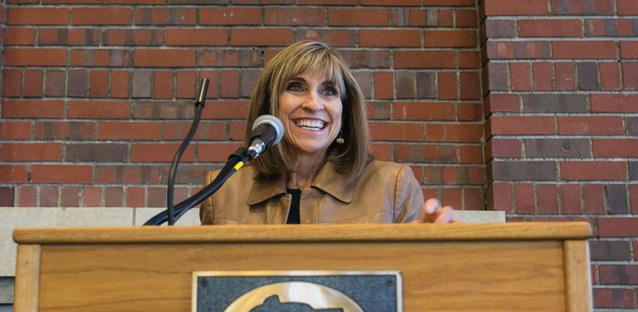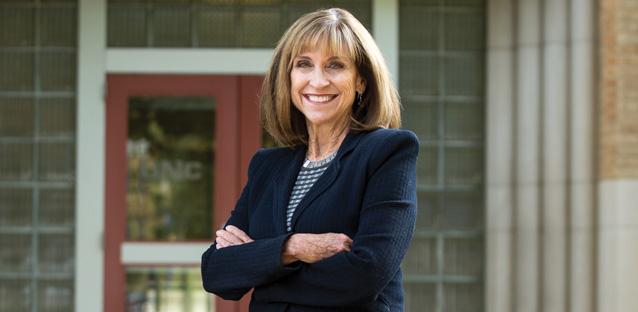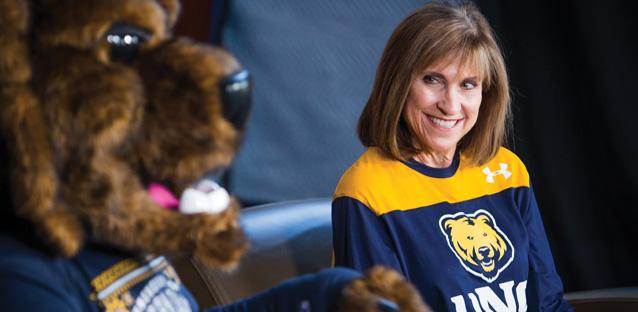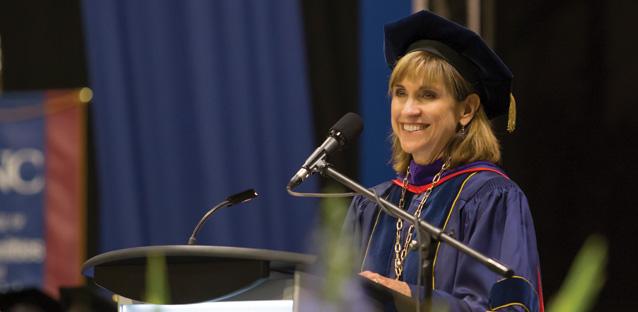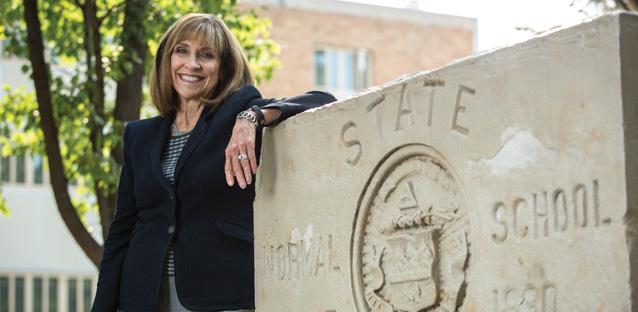Retiring UNC President Kay Norton presided with calm — and adapted along the way — during a tumultuous time in university history.
By Gloria Reynolds
Kay Norton’s first day as UNC president was a Tuesday without fanfare. The morning of July 2, 2002, was clear and sunny, and the breeze picked up in the afternoon as the thermometer headed for 96. Otherwise, things were pretty bleak.
The smell of smoke from Colorado’s largest-ever wildfire 80 miles southwest of town lingered on campus. The Colorado Legislature had just asked UNC to return $7.8 million of its annual appropriation to help balance the state budget. Across the nation, investors reeled from corporate scandal of historic proportion, including the collapse of Enron and WorldCom. The stock market was soon to hit a four-year low.
Press reports of Norton’s first day focused on the fact that UNC’s 12th president was the first woman to hold the job. But many faculty, students and staff were still fixated on the contentious, months-long search that named her as the sole finalist for the position. Norton had little interest in either conversation.
Neither was she interested in having a traditional inauguration. Nor would she give the customary State of the University Address that fall, asserting that it was impossible to assess the state of the university just a few weeks into the job. She just wanted to get to work.
Up for the Challenge
No one envisioned in 2002 that Norton would be UNC president for 16 years. At the time, the average tenure of university presidents had fallen under seven years, and that statistic wasn’t the only thing working against Norton. UNC was heading into one of the most tumultuous periods in the recent history of higher education. “Quite a lot of Kay’s presidency has been concerned with trying to respond to larger matters beyond any of our control,” says Emeritus Professor of Philosophy Jack Temkin, who was chair of UNC’s Faculty Senate when Norton took office and on the senate for most of her tenure.
In 2002, competition for students was already growing keener as the number of high school graduates leveled off yet colleges and universities continued to proliferate. At UNC, as across the nation, student bodies were becoming increasingly diverse not only in demographics, but also in academic preparation, interests, needs and ability to pay for college. At the same time, the first of two economic crises within a decade was limiting state funding for universities, with Colorado outpacing almost every state in cutting back.
Colorado ranked 47 in higher education funding in 2002 and has ranked 48 for most of Norton’s tenure. Even now, UNC has not reached the $44.8-million mark of its initial appropriation the year she became president and had to return $7.8 million. Over the past 16 years, UNC’s state funding graphs like a roller coaster, ending 2018 just $2.6 million higher than 2002 ended.
None of this was a surprise to Norton. She relished the challenge.
University of Hard Knocks
Eager to get to work, Norton launched a planning process that dogs her to this day. Even when there are accolades, that process — Charting the Future — is often mentioned as a somber prelude.
“In the beginning, there was chaos; it started horribly with the plan for the future,” says Emeritus Professor of Astronomy Richard Dietz, who chaired the Faculty Senate during the planning. Since arriving on campus in 1969, Dietz has seen six presidents, three interim presidents and well over a third of UNC’s history. He considers those Charting the Future years one of the two most tumultuous times in 49 years. But he goes on to say: “Probably more than any other president I’ve known, Kay learned from her mistakes. I think she was one of the better presidents during my time here, and I’m sorry to see her go.”
Charting the Future asked faculty and staff to respond to UNC’s financial challenges by rethinking the way they’d always done things. It was the quintessential culture clash. Though Norton spent four years as UNC’s vice president of university affairs, general counsel and secretary to the Board of Trustees before she was president, she’d spent most of her career as an attorney at ConAgra Red Meat Companies. The pace and style of executive leadership at the meat packing company bore no resemblance to expectations at UNC. “She came in too much wanting this to be a business,” says current Faculty Senate Chair and Professor of Special Education Francie Murry. “She had a vision, but she didn’t understand the role of faculty.”
“That first year was a nightmare,” says Norton. The more people questioned her, the harder she tried to explain; and the harder she tried to explain, the less people thought she was willing to listen. “I completely failed to account for the human factor,” she says. “Tremendous time and energy and angst were spent on the wrong things. The big lesson for me was that everyone doesn’t think like me. And that you have to build trust — have to earn it.”
While Charting the Future is the most remembered, it wasn’t Norton’s only learning opportunity. Over time, it seemed she even began finding some perverse pleasure in reminding people of failed attempts that led to success. In 2012, when campus coalesced around a compensation plan after two years of work, Norton attributed its success to lessons learned from the 2004 Commission on Compensation that went nowhere, and another attempt in 2007. When she pushed legislators for $38 million for the Campus Commons in 2014, she emphasized UNC’s repeated attempts to plan and fund a student-focused building at the heart of campus, telling them: “We’ve finally got it right.” Norton describes the Campus Community and Climate division she created in 2016 as “culmination of a decade-long search for how we address community.”
Despite being the longest-tenured university president in Colorado, Norton says she’s still learning on the job. “I don’t think it diminishes a person one bit to discover they were wrong,” she says. “We learn from our mistakes; that’s what we’re all about.”
Despite the Odds
Encountering challenges, Norton refused to be a victim or to let UNC play the role of victim. On the tenth anniversary of her presidency, Professor of Theatre Arts and then Faculty Senate Chair Mary Schuttler noted that the traditional gift for such an occasion — something made of tin or aluminum — was fitting. “Both symbolize flexibility and durability,” she said. “They also symbolize the ability to bend without breaking, which is certainly reflective of Kay Norton’s current term in office.”
Norton persistently reminded campus that it was necessary but not sufficient to adapt
to less state funding; UNC also had to adapt to changing students. She embraced the
changing landscape as an opportunity for UNC to be master of its own fate. But the
magnitude of change put Norton in a “vortex of a million things going on at once,”
says Murry, who is now chairing Faculty Senate for the third time during Norton’s
tenure. Scarcity of resources made it especially hard to foster collaboration, Murry
says. “Kay had this vision of working across colleges, and as soon as the pie got
smaller, everyone
said this is mine, mine, mine.”
Despite the odds, since 2002 UNC has increased the number of degrees and certificates it offers students by more than 30 percent and expanded its extended campus more than 300 percent. As the university increased tuition, it also increased its annual investment in financial aid from $4 million to over $40 million, primarily in need-based aid. UNC twice earned reaccreditation from the Higher Learning Commission, moved from NCAA Division II to Division I and joined the Big Sky Conference. Despite the virtual disappearance of state capital funding, UNC also built two major residence halls, a new dining facility and the Campus Commons. In Fall 2017, UNC reached its highest enrollment in a decade and welcomed almost twice as many students of color as 15 years earlier.
“I think we’ve been very persistent in our journey to continue to grow and get better and create a campus where people are proud to say, ‘I’m a UNC graduate,’” says Dick Monfort, who has chaired UNC’s Board of Trustees since 1999. “The fact that we grew the university in stature during a time of almost no new state funding is an accomplishment — an accomplishment for the entire university,” he says.
Norton has “put UNC on the map” and given it a presence among Colorado’s major universities, says Monfort. “She took a sleepy little school and made it a first-class university” by building strong academic programs, improving faculty salaries, making campus look more collegiate, and getting UNC into the Big Sky Conference, he says. Before Norton, people thought of UNC as a small regional college like Colorado Mesa or Adams State, but “now people are making decisions about going to UNC or CSU, or going to CU or UNC,” he says. “We compete with major universities.”
Monfort calls Norton a forward thinker on the look of campus, saying: “We took a ragtag set of buildings and tied them together and created the campus look and feel of a major university.” The new Campus Commons is part of that look, he says, but what’s more important is its student focus. “That it is totally student centered — that it’s about how to make life easier on students — I think that will be a legacy of hers,” he says.
According to Temkin, an important part of Norton’s legacy will also be things unseen. “Kay has had a key role in preventing some things that would have been very bad,” he says. For example, she didn’t try to balance the budget by cutting faculty positions or academic programs, he says, “even though that would have been the first step for most presidents.”
Strong, Silent Type
Norton pointedly avoids talking about legacy. A student of literature and a voracious newsreader, she knows that events are often reinterpreted over time. She scoffs at the notion of attempting to shape what people may someday think of her. “It’s not about I did this or that. A lot of times, those things are illusory,” she says. “I’m proud of what I’ve done, but I’m not expecting some great legacy.”
There’s broad agreement that Norton kept a lower profile than most presidents; whether that helped or hampered her work is a matter of debate. “I think she can’t win on that one,” says Temkin. Some people think presidents should be out and about on campus, and others think they should “do the things that only presidents can do,” he says. Either approach is an easy target for those who want to criticize. “There’s an expression that’s become common … haters gonna hate,” he says. “Nothing you can do about it. I think that’s what goes on a lot — not just with Kay, but with people in high positions.”
Part of being president is not taking things personally, says Norton. “You have to understand that you’re likely to be misunderstood. In a public position, people are going to ascribe motives to you that aren’t true,” she says. “I wasn’t seeking popularity,” she notes. “I’ve never put a lot of effort into that. It’s really wrong to use that kind of lens when you’re talking about being the leader of a university.”
Not worrying about popularity makes it easier to have hard conversations, says Murry, who’s had plenty of them with Norton. “She didn’t need me to think she was marvelous,” she says. “That’s what I like about her: She didn’t need me to like her.” Because of that, they had incredibly frank conversations, says Murry. “There was never anything I couldn’t say to her.”
Norton’s approach is the antithesis of building a cult of personality. “People come and go,” she says. “It happens with students every year. It’s why the university is an organic thing and why it continues. Leaders are important, but it’s about community, not individual leaders.” Almost 16 years after starting the job, she still just wants to do the substantive work. “What matters to me is making sure that UNC can continue to provide generations of future students the opportunity to fulfill their potential,” she says. “Leadership is about doing a lot of hard things, and not measuring whether you’re succeeding by whether your poll numbers are up.”
Keeping score gets leaders in trouble, says Norton, who hates the idea of winners and losers. She much prefers the do-over, and early lessons of Charting the Future taught her to let go gracefully when things don’t work. Temkin notes: “I have some difficulty letting go of things that are very important to me, and I have learned from Kay that doing that gracefully can get you even more than you wanted.”
Monfort, too, appreciates Norton’s grace under fire, calling her “a calming force” at UNC. “I think I’ve always had a sense of frustration with the pace of higher education — but rather than be a bull in a china shop, I’ve learned you have to be patient,” he says. “Kay taught me that: a little tug here and a little tug there, and you gradually get things done.”
Quiet Passion
Norton’s persistence and resilience are widely recognized, but her passion for UNC surprises some.
“When you spend 16 years at a place, it means something,” says Monfort. “She stayed. Kay is smart, she’s a lawyer, and I’m sure she had many opportunities along the way — and this became her passion.”
That passion, says Temkin, is selfless. “She doesn’t put herself before this university. That is the most important thing about her,” he says. Norton’s love for UNC developed over time, he says, as she got to know the university and identify with the students it serves. Recalling a meeting in her office about midway through her presidency, he says: “As I was getting up, she said, with tears in her eyes, ‘You love this place too.’” He’d sensed a growing connection, but “that’s when I was really sure” that Norton had fallen in love with UNC, he says.
Nowhere was Norton’s growing love for UNC more apparent than at commencement. Early in her tenure, she seemed to consider it a chore, a two-day commitment with lots of fanfare and little meaning. But that soon changed, as the students and families she met inspired her, and she began repeating their stories to anyone who would listen. Last September, as she looked ahead to her final year as president, talking about commencement was the thing that choked her up every time.
“The students who walk across that stage at graduation — they are the most important reason you want to work here,” says Norton. “What happens at UNC is so much greater than all of us. Students come here seeking the transformative power of education, and whoever you are, wherever you come from, you’ve got a shot at UNC. I truly believe this is a place where the American Dream still lives.” UNC
–Gloria Reynolds, a onetime journalist, has served as Norton’s chief of staff since 2008.

